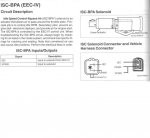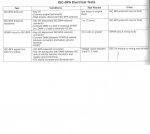yo,
http://i165.photobucket.com/albums/u64/Rwanda01/Bronco/ECTs001copy.jpg
ECT Location pic in an 89 351W; behind/&
passenger side of the distributor Source: by BigBlue89Bronco
Location Diagram in 87-91 (from Factory Manual and the Ford Electrical & Vacuum Troubleshooting Manual (EVTM) Source: by Broncobill78 (Dave) at Ford Bronco Zone Forums
Ford went from two-digit to three-digit EEC IV Self-Test codes in 1991
DTC 21 ECT out of self test range 0.3 to 3.7 volts;
"...
engine not warmed up, bad thermostat, low coolant..
Coolant is less than 50 deg F for KOEO, or less than 180 deg F for KOER, or greater than 250 deg F for either. I would check the thermostat too.
If coolant temp is in proper range, suspect ECT sensor or it's connector/wiring.
Testing; "..."But due to its simplicity of design, the ECT is rarely at fault when problems occur. Before testing the ECT or any other EFI component perform a self-test, trouble codes received during test can be used as a diagnostic tool along with other indicators. To test an ECT sensor you will need a volt meter. You can test the ECT by back probing the harness while reading the voltage returning to the EEC. Or you can removing the connector completely and test the resistance between the 2 pins on the ECT..." READ MORE Source: by Ryan M (Fireguy50) at fordfuelinjection.com
"Before you start blaming the engine coolant temperature sensor and replacing it make sure the rest of the coolant system is in good condition. All of the following items will affect the ECT:
*Coolant level
*Radiator Fan
*Water Pump
*Water Pump and Fan Belts
*Thermostat
*Base Timing
*Engines general condition
*Harness and wire general condition
See site for diagrams and test chart & connector pin-out info
The Engine Coolant Temperature (ECT) sensor is a thermal transistor, which means it allows less electricity to pass through the sensor the warmer it gets. The ECT receives the �Signal Return� voltage from the EEC, then allows a certain amount to return back to the EEC. Because the ECT is in direct contact with the engine coolant flow it changes resistance in response to the temperature of that coolant.
The ECT is third in command in the hierarchy of EFI sensors, this means this sensor is very important when calculating fuel ratios and timing curves. This is because of simply chemistry; fuel and spark are constants in the equation. Air is the biggest variable in combustion; it changes density greatly over a range of temperature. So keeping track of the changing temperatures of the incoming air and the engine in which it is burnt becomes very important. But due to its simplicity of design, the ECT is rarely at fault when problems occur.
Before testing the ECT or any other EFI component perform a self-test, trouble codes received during test can be used as a diagnostic tool along with other indicators. To test an ECT sensor you will need a volt meter. You can test the ECT by back probing the harness while reading the voltage returning to the EEC. Or you can removing the connector completely and test the resistance between the 2 pins on the ECT. The engine temperature must be greater than 50�F (10�C) to pass the KOEO Self-Test and greater than 180�F (82�C) to pass the KOER Self-Test. To accomplish this, the engine should be at normal operating temperature.
Values were calculated for VREF = 5.0 volts. These values may vary 15 percent due to sensor and VREF variations."
MIESK5 NOTE; if VREF is Not 5.0 volts or close. then there is a wiring/connector terminal issue from EEC to ECT or possibly EEC damage. But other Sesnors' (such as TPS, EGR, etc.) codes would come up if EEC is damaged or VREF is off. VREF wires share the same reference voltage circuit w/ many sensors & share the same ground circuit.
miesk5 NOTE; batty should be 12.6 volts at rest after a charge
DTC 21, 51, 61 or 116, 117, 118 "...Failure in either the circuit or temperature sensor will show code 21, 51, 61 or 116, 117, 118.Unplug the harness connector. First, check the signal voltage at the connector with the key on, engine off. Should be approximately 5.0v. Then, check the resistance of the sensor cold. Should be between 58,750 to 40,500 ohms. Plug in the harness connector and warm up the engine to normal operating temperature. Then, unplug and check the resistance of the sensor hot. Should be 3,600 to 1,840 ohms...'
Source: by Seattle FSB
Wiring Diagram in 87-89 Bronco & F series (Mitchell)

Source: by equivalent (Beetlejuice) at SuperMotors.net
===--------------
DTC 12 can't control engine RPM high RPM self test; vacuum leak, TB base idle off, IAC dirty or bad, EGR stuck open. Check the IAC valve port in TB for Sludge; Suspect throttle body coking.
Source: by miesk5
Idle Air Control (IAC); also called, Idle Air Bypass (IAB), Idle Speed Control (ISC), Throttle Bypass Air, Idle Bypass, Inlet Air Controller, Inlet Air Bypass, Intake Air Bypass, Intake Air Control
Idle Air Control (IAC) Sludge; Poor Idle TSB 91-25-07 for 85-92 Bronco & F Series & many others; "...Hard cold starts, hesitation and stalls on initial start-up or during idle or decel may be caused by sludge in the throttle body and/or idle by-pass valve. Sludge deposits or oil film on the throttle body bore and plate or the idle air by-pass valve may cause one or more of the following conditions. Hard Cold Start, Stall On Initial Start-Up, Stall During Idle, Stall During Decel, Rough Idle, Rolling Idle, Hesitation During Acceleration. A new idle air by-pass service kit (F2PZ-9F939-A) is now available for service use to correct sludge contamination concerns of the throttle bore and plate only. It eliminates the need to clean the majority of past model throttle body applications. Cleaning is not required on sludge tolerant throttle body designs released for 1991 and newer model years..." Source: by Ford via Steve83
There is another person working w/this TSB here in another thread; he is about to modift the IAC Gasket to allow more air flow in instead of buying the new part.
Testing & Diagnostic Trouble Codes (DTC), Chapter 12, from Ford Fuel Injection and Electronic Engine Control: How to Understand, Service and Modify, 1988-1993
Source: by Charles O. Probst @
http://www.yunost.ru/docs/Ford-injectors-book/Part12/Part12-1/Part12-1.pdf
7.66 MB pdf file
See page 292; ISC-BPS



